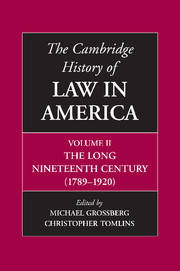Book contents
- Frontmatter
- 1 Law and the American State, from the Revolution to the Civil War: Institutional Growth and Structural Change
- 2 Legal Education and Legal Thought, 1790–1920
- 3 The Legal Profession: From the Revolution to the Civil War
- 4 The Courts, 1790–1920
- 5 Criminal Justice in the United States, 1790–1920: A Government of Laws or Men?
- 6 Citizenship And Immigration Law, 1800–1924: Resolutions Of Membership And Territory
- 7 Federal Policy, Western Movement, and Consequences for Indigenous People, 1790–1920
- 8 Marriage and Domestic Relations
- 9 Slavery, Anti-Slavery, and the Coming of the Civil War
- 10 The Civil War And Reconstruction
- 11 Law, Personhood, and Citizenship in the Long Nineteenth Century: the Borders of Belonging
- 12 Law in Popular Culture, 1790–1920: The People and the Law
- 13 Law and Religion, 1790–1920
- 14 Legal Innovation and Market Capitalism, 1790–1920
- 15 Innovations in Law and Technology, 1790–1920
- 16 The Laws of Industrial Organization, 1870–1920
- 17 The Military in American Legal History
- 18 The United States and International Affairs, 1789–1919
- 19 Politics, State-Building, and the Courts, 1870–1920
- Bibliographic Essays
- Notes on Contributors
- Index
- References
2 - Legal Education and Legal Thought, 1790–1920
Published online by Cambridge University Press: 28 November 2008
- Frontmatter
- 1 Law and the American State, from the Revolution to the Civil War: Institutional Growth and Structural Change
- 2 Legal Education and Legal Thought, 1790–1920
- 3 The Legal Profession: From the Revolution to the Civil War
- 4 The Courts, 1790–1920
- 5 Criminal Justice in the United States, 1790–1920: A Government of Laws or Men?
- 6 Citizenship And Immigration Law, 1800–1924: Resolutions Of Membership And Territory
- 7 Federal Policy, Western Movement, and Consequences for Indigenous People, 1790–1920
- 8 Marriage and Domestic Relations
- 9 Slavery, Anti-Slavery, and the Coming of the Civil War
- 10 The Civil War And Reconstruction
- 11 Law, Personhood, and Citizenship in the Long Nineteenth Century: the Borders of Belonging
- 12 Law in Popular Culture, 1790–1920: The People and the Law
- 13 Law and Religion, 1790–1920
- 14 Legal Innovation and Market Capitalism, 1790–1920
- 15 Innovations in Law and Technology, 1790–1920
- 16 The Laws of Industrial Organization, 1870–1920
- 17 The Military in American Legal History
- 18 The United States and International Affairs, 1789–1919
- 19 Politics, State-Building, and the Courts, 1870–1920
- Bibliographic Essays
- Notes on Contributors
- Index
- References
Summary
The years from 1790 to 1920 saw the transformation of American society from an agrarian republic of 4 million people huddled on the Atlantic seaboard to a continental nation of some 105 million people, recognized as the dominant financial and industrial power in the world. Legal education (and legal culture generally) responded to and reflected the historical forces behind this radical transformation. In 1790, aspiring lawyers learned law and gained admission to practice by apprenticing themselves to practicing lawyers. Law office law unavoidably tended to be local law. By 1920, 143 law schools (most affiliated with universities) dominated – indeed, all but monopolized – legal education and were close to controlling entry into the profession. Through their trade group, the Association of American Law Schools, and with the support of the American Bar Association, they had by the beginning of the 1920s created the institutional mechanisms for defining, if not fully implementing, national standards for legal education. In legal education as in many other areas of American society, institutionalization and organization were the keys to power, and power increasingly flowed from the top down.
The normative assumptions of this new educational regime emanated from the reforms first introduced by Dean Christopher Columbus Langdell at Harvard Law School in 1870. Langdell’s ideas were stoutly resisted, initially even at Harvard. They were never implemented anywhere else in pure form, and they were rooted more deeply in tradition than Langdell acknowledged. Nevertheless, his institutional and pedagogic innovations became the common denominator of modern legal education.
- Type
- Chapter
- Information
- The Cambridge History of Law in America , pp. 36 - 67Publisher: Cambridge University PressPrint publication year: 2008
References
- 2
- Cited by

